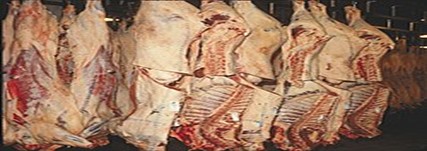The consumer faces an on-the-go lifestyle that demands consistent, high-quality foodstuffs that are convenient to prepare. These and other attributes are important in driving consumer purchasing of meats. Producers recognize that management practices could affect product quality and are important to consumers. You want consistently high quality, safe, and nutritious foods that are easy and convenient to prepare.
Therefore, you as producer should take the following into consideration:
- Consumers want meat products that are tender, safe, nutritious, and conveniently available.
- You should measure the consumers’ acceptance and willingness to pay for new products and different product attributes.
When you harvest products (meat), you should do it as early as possible, meaning, when the animal is produced economically. For example, for animals that are used for lamb, production must be early matured so that they can be slaughtered at a very early stage e.g. 4 – 6 months (± 40kg live mass). At this stage, the animal’s daily requirements are still low and its feed conversion ratio (FCR) is still high. FCR: The amount of feed needed to produce 1 kg of meat.
The illustration that follows shows that at ± 5 months muscle is at an optimum and after ± 6 months fat deposited increases, whereas muscle decrease relative to fat deposition. Mutton and lamb differ from each other in that lambs are slaughtered very young and before much connective tissue has developed, hence their meat is very tender. Mutton, having more connective tissue, is less tender but also very tasty on account of its higher proportion of connective tissue. During cooking, the white connective tissue (collagen) is converted into gelatine, which makes mutton as tender and tasty as a lamb.
Both beef and mutton can be harvested at different stages. Breeding stock is slaughtered only at the end of their productive lives, but their offspring are slaughtered when they will produce the best quality meat. For most mutton sheep breeds this is when a body mass of between 35 and 45 kg is reached depending on the breed.
Breeds that tend to put on fat at an early age such as the Dorper, Persian and fat-tailed breeds will be slaughtered at between 35 – 42 kg. At this stage, the lambs will have very little fat and tender meat.
The mass of the carcass is approximately 45% of the live body mass of approximately between 17 – 20 kg. This will give a high-quality carcass.
Other breeds such as the S A Mutton Merino, the Dormer and other breeds that put on fat later will produce carcasses with weights between 20 – 25 kg with the same characteristics as the lighter carcasses.

Young cattle vary more and are mostly fed in a feedlot (a place where animals are fattened for slaughtering) until they reach the correct slaughter stage. They are then slaughtered depending on their fatness and depending on the breed. The carcass mass can vary a lot.
The carcass is also classified in the same manner as that of sheep and pigs on age, fat distribution and body conformation or condition score.
To assess if a sheep is ready for slaughter one must measure its weight, deposition and distribution of fat on the potential carcass. There is a method that can be used to determine these qualities in the crush before the sheep is slaughtered.
While the sheep is standing in the crush one can easily feel the amount of fat deposited on the back of the animal. By placing the thumb and middle finger on either side of the spinal column at the juncture to the ribcage, when moving the hand back and forth whilst having a firm grip, the handler will feel the amount of fat distribution as a soft rubbery mass under the skin.
If the feeling underhand below the skin is still bony and sinewy it is a good indication that the animal is still too lean to be slaughtered. By weighing the animal, the handler will also have a good idea of its readiness for slaughter and by observing the measure of muscle development on the shoulders and thighs.
Remember the modern consumer market prefers a fairly lean product which is tender and that must be the focus of the inspection.
Click here to learn more about how to determine market readiness.